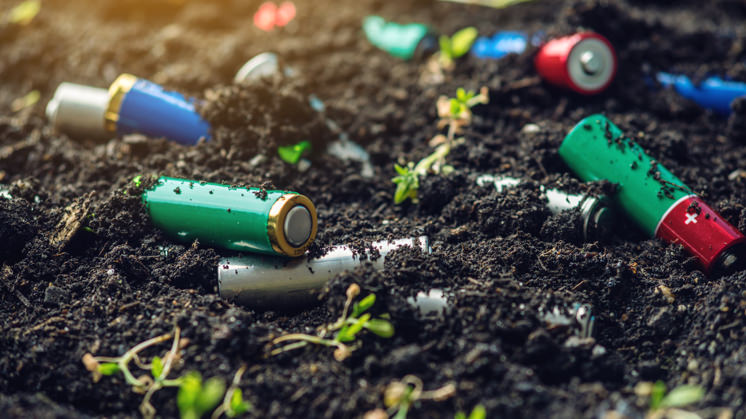Poluição do solo
A poluição do solo, seus efeitos no nosso futuro e o que podemos fazer para reduzi-la
Quando falamos de poluição temos a tendência de levantar os olhos, mas este problema não afeta só aos nossos céus. Os solos, onde cultivamos frutas, legumes ou hortaliças, também sofrem as consequências. Por exemplo, seus efeitos chegam até nós por meio dos alimentos anteriormente mencionados. Chegou a hora de cuidar da terra que está debaixo dos nossos pés!

A superfície terrestre é a pele do planeta, um manto cheio de cicatrizes, rugas milenares e feridas mais recentes causadas tanto pelo homem como pela própria natureza. Algumas destas úlceras são incuráveis — como a extinção de espécies — outras comprometem a saúde e a segurança alimentar e todas elas ameaçam o bem-estar de metade da humanidade no mundo, conforme alerta o relatório Global Land Outlook (GLO2), Land Restoration for Recovery and Resilience (Restauração da terra para recuperação e resiliência), publicado em 2022 pela Convenção das Nações Unidas de Combate à Desertificação. O relatório destaca que a poluição é a maior causa ambiental de doenças e mortes no mundo atualmente, principalmente a poluição do solo, juntamente com a exposição a produtos químicos e a má gestão de resíduos.
O que é a poluição do solo
Este mal invisível aparece quando a concentração de componentes poluentes na superfície é tão alta que causa danos na biodiversidade do solo e coloca em risco a nossa saúde especialmente através da alimentação. Mais precisamente, atividades como a pecuária e a agricultura intensivas costumam utilizar medicamentos, pesticidas e fertilizantes que contaminam os campos, da mesma forma que acontece com os metais pesados e outras substâncias químicas de origem natural ou antropogênica.
A poluição do solo é uma ameaça global particularmente grave em regiões como a Europa, Eurásia, Ásia e norte da África, tal como revela a Organização das Nações Unidas para a Alimentação e a Agricultura (FAO). Este organismo internacional também afirma que a degradação intensa ou moderada já afeta um terço do solo mundial, e sua recuperação é tão lenta que seriam necessários 1.000 anos para criar alguns centímetros de camada arável superficial.
Causas e tipos de contaminação do solo
Fenômenos tais como a erosão, a perda de carbono orgânico, a salinização, a compactação, a acidificação e a poluição química são os principais responsáveis da deterioração atual do solo. Além disso, a FAO diferencia entre estes dois tipos de poluição edáfica:
- Poluição pontual: ocorre por razões específicas, acontece em áreas reduzidas e suas causas são fáceis de identificar. Esta poluição terrestre é comum nas cidades, em locais de antigas fábricas, arredores de estradas, lixeiras ilegais e estações depuradoras.
- Poluição difusa: inclui territórios muito amplos e suas causas são diversas ou difíceis de identificar. Este tipo envolve a dispersão de poluentes através de sistemas ar-solo-água e tem um impacto importante na saúde humana e no meio ambiente.
Para a FAO, entre as causas antropogênicas mais comuns da poluição do solo destacam-se: a indústria, a mineração, as atividades militares, a gestão de resíduos — incluindo o lixo tecnológico — e as águas residuais, a agricultura, a pecuária e a construção de infraestruturas urbanas e de transportes.
Consequências da contaminação do solo
As substâncias tóxicas que se depositam na superfície terrestre prejudicam a nossa saúde e bem-estar, bem como a qualidade dos alimentos, da água e do ar. A seguir, detalhamos os efeitos mais relevantes de acordo com a IPBES e a FAO:
 Danos para a saúde
Danos para a saúde
Os poluentes da terra passam ao nosso organismo pela cadeia trófica, propiciando o aparecimento de doenças. Além disso, a disseminação dos antibióticos no meio ambiente favorece a resistência dos patógenos a estes medicamentos.
 Piores cultivos
Piores cultivos
Os agentes da poluição do solo comprometem a segurança alimentar da população mundial ao diminuir a quantidade e a qualidade das colheitas.
 Mudanças climáticas
Mudanças climáticas
De 2015 a 2050, 69 gigatoneladas de CO2 serão emitidas como resultado da mudança no uso da terra e da degradação do solo, um número que representa 17% das emissões atuais de gases de efeito estufa a cada ano.
 Poluição da água e do ar
Poluição da água e do ar
A deterioração da superfície terrestre repercute na qualidade da água e do ar, especialmente nos países em vias de desenvolvimento.
 Deslocamentos de populações
Deslocamentos de populações
A degradação do solo e as mudanças climáticas obrigarão que emigrem entre 50 e 700 milhões de pessoas até o ano 2050.
 Desaparecimento de espécies
Desaparecimento de espécies
A poluição do solo é uma das principais causas que poderiam desencadear a sexta extinção em massa da história —a população de animais selvagens sofreu uma queda de 69% entre 1970 e 2018, de acordo com o Relatório Planeta Vivo da WWF—.
 Desertificação
Desertificação
O número de habitantes das áreas mais áridas do planeta poderia significar 45 % da população mundial em 2050, enquanto as zonas úmidas do mundo perderam 87 % de sua área nos últimos três séculos.
 Impacto na economia
Impacto na economia
Estima-se que as perdas econômicas globais originadas da deterioração do solo cheguem a metade do Produto Interno Bruto (PIB) mundial anual.
Soluções para reduzir a poluição do solo
A degradação do solo é um problema complexo que exige medidas conjuntas por parte dos governos, instituições, comunidades e indivíduos. Estas são algumas das coisas que podemos fazer para melhorar sua saúde:
- Consumir alimentos sustentáveis, reciclar corretamente pilhas e baterias, fazer compostagem caseira ou doar medicamentos nos lugares existentes para este fim.
- Incentivar um modelo mais ecológico de indústria, agricultura e pecuária, entre outras atividades econômicas.
- Melhorar o planejamento urbano das cidades e do transporte, bem como o tratamento das águas residuais.
- Reformar a gestão dos resíduos da mineração, restaurar a topografia e conservar a camada superficial do solo.
- Incluir as comunidades locais e os povos indígenas na elaboração, implementação e avaliação da gestão sustentável do solo.






